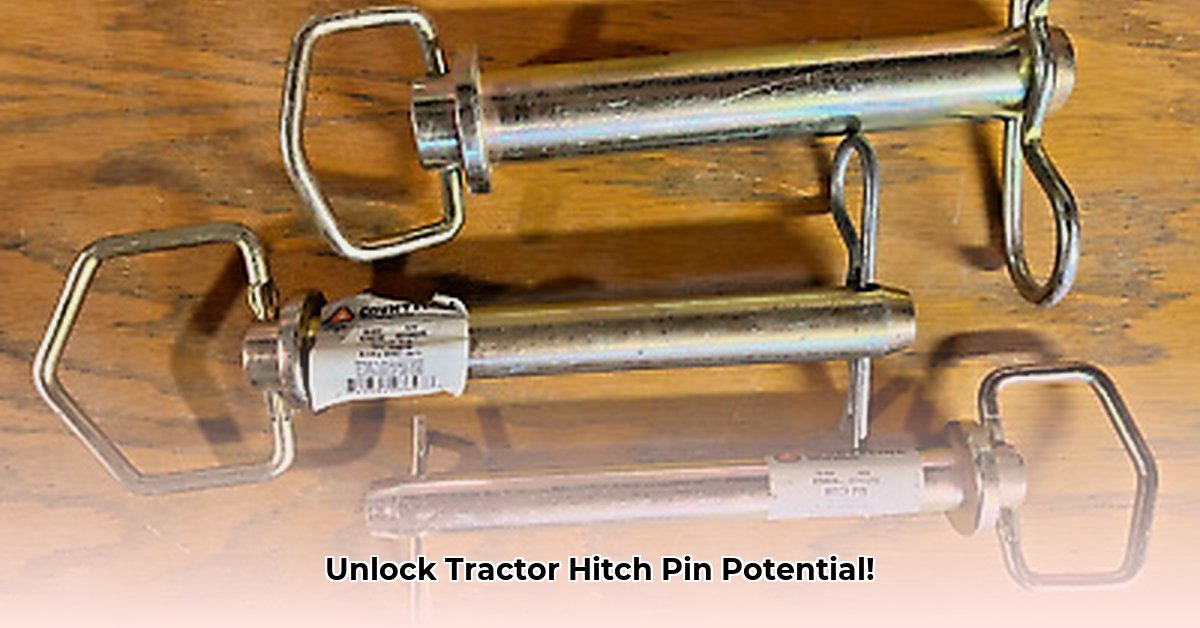
Maintaining peak efficiency and minimizing environmental impact are paramount in modern agriculture. Often overlooked, 3-point hitch pins play a crucial role in achieving these goals. This guide, focusing on Tractor Supply's offerings, provides actionable steps for selecting, installing, and maintaining these essential components, directly impacting your farm's sustainability and bottom line. For more detailed information on Tractor Supply's 3-point hitch offerings, check out this helpful resource: Tractor Supply Hitch Pins.
Choosing the Right 3-Point Hitch Pins
Selecting the correct pin isn't simply about finding a metal rod that fits; it's about ensuring safe and efficient operation. The wrong pin can lead to equipment failure, costly repairs, and reduced productivity. Consider these key factors:
Implement Weight and Size: Heavier implements demand stronger, larger-diameter pins to prevent bending or breakage. Always consult your implement's manual for the recommended pin size. Ignoring this can lead to catastrophic equipment failure. Don't risk it!
Pin Material: High-quality steel pins offer superior strength and durability compared to cheaper alternatives. Hardened steel pins, readily available at Tractor Supply, provide even greater resistance to wear and tear, further extending their lifespan and minimizing replacements.
Pin Type: Various pin types exist, each with specific applications. Clevis pins, for example, are common and offer a robust connection, while quick-release pins can save time during implement changes. Choosing the correct type ensures a secure and efficient connection.
Frequency of Use: Daily use requires a more robust pin than one used only occasionally. Investing in higher-quality pins for frequently used implements minimizes downtime and maximizes operational efficiency.
Installing and Removing 3-Point Hitch Pins Safely
Safety is paramount when working with agricultural machinery. Always follow these steps:
Safety First: Ensure the PTO (power take-off) shaft is disconnected and the tractor's ignition is off before handling any components of the 3-point hitch.
Prepare the Hitch: Clean any debris from the implement's mounting points and the tractor hitch This ensures smooth pin insertion and prevents damage.
Insert the Pin: Carefully guide the pin into the lower link's hitch pin hole. Gentle pressure is acceptable; excessive force indicates a problem.
Secure the Top Link: After inserting the lower link pin, secure the top link's clevis pin. Verify alignment and secure fit.
Raise the Implement: Slowly raise the implement using the tractor's hydraulic system. Watch for uneven movement or resistance, indicating a potential issue.
Final Check: Thoroughly inspect the pins and connections for secure fastening and the absence of stress or bending. Carefully test the implement's movement.
Maintenance for Optimal Performance and Longevity
Regular maintenance ensures your pins remain dependable, reducing the risk of costly repairs and maximizing your investment.
Lubrication: Applying a light coat of grease or suitable lubricant before each use minimizes friction and extends pin lifespan. This simple step dramatically reduces wear and tear.
Inspection: After each use, inspect pins for wear, bending, or damage. Replace any damaged pins immediately. A bent or damaged pin significantly compromises safety and operational efficiency.
Cleaning and Storage: Clean pins of mud and debris. Store them in a dry, clean area, protecting them from corrosion and extending their useful life.
The Sustainable Farming Connection
Maintaining 3-point hitch pins directly contributes to sustainable farming practices. By preventing breakdowns and maximizing equipment longevity, you:
- Reduce Fuel Consumption: Minimized downtime translates to less tractor operation and lower fuel costs, reducing environmental impact.
- Minimize Waste: Extending equipment life reduces the need for frequent replacements, preventing unnecessary waste generation.
- Enhance Efficiency: Reliable equipment ensures timely completion of tasks, maximizing resource utilization.
Troubleshooting Common Problems
Pin Won't Insert: Inspect for obstructions in either the hitch or the pin itself. A slightly bent pin may impede insertion.
Pin Feels Loose: A loose pin signals wear and necessitates replacement. Ignoring this compromises safety and can lead to catastrophic failure.
Implement Won't Lift: Verify both pins are correctly seated. Examine the hydraulic system for proper operation.
Conclusion: Small Actions, Big Impact
Properly selecting, installing, and maintaining 3-point hitch pins is a simple yet impactful practice. By prioritizing this crucial aspect of farm equipment upkeep, you contribute to a more efficient, productive, and environmentally friendly operation. Invest in the longevity of your farm—start with your pins.